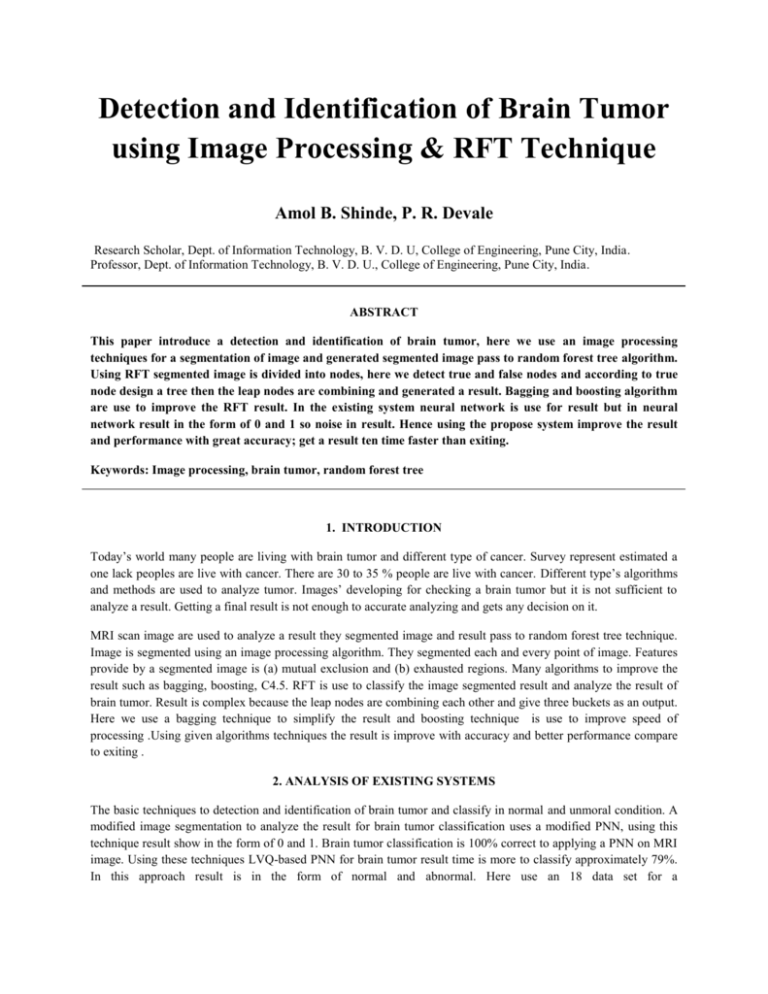doc_02_09_2015_13_22_58
advertisement

Detection and Identification of Brain Tumor using Image Processing & RFT Technique Amol B. Shinde, P. R. Devale Research Scholar, Dept. of Information Technology, B. V. D. U, College of Engineering, Pune City, India. Professor, Dept. of Information Technology, B. V. D. U., College of Engineering, Pune City, India. ABSTRACT This paper introduce a detection and identification of brain tumor, here we use an image processing techniques for a segmentation of image and generated segmented image pass to random forest tree algorithm. Using RFT segmented image is divided into nodes, here we detect true and false nodes and according to true node design a tree then the leap nodes are combining and generated a result. Bagging and boosting algorithm are use to improve the RFT result. In the existing system neural network is use for result but in neural network result in the form of 0 and 1 so noise in result. Hence using the propose system improve the result and performance with great accuracy; get a result ten time faster than exiting. Keywords: Image processing, brain tumor, random forest tree 1. INTRODUCTION Today’s world many people are living with brain tumor and different type of cancer. Survey represent estimated a one lack peoples are live with cancer. There are 30 to 35 % people are live with cancer. Different type’s algorithms and methods are used to analyze tumor. Images’ developing for checking a brain tumor but it is not sufficient to analyze a result. Getting a final result is not enough to accurate analyzing and gets any decision on it. MRI scan image are used to analyze a result they segmented image and result pass to random forest tree technique. Image is segmented using an image processing algorithm. They segmented each and every point of image. Features provide by a segmented image is (a) mutual exclusion and (b) exhausted regions. Many algorithms to improve the result such as bagging, boosting, C4.5. RFT is use to classify the image segmented result and analyze the result of brain tumor. Result is complex because the leap nodes are combining each other and give three buckets as an output. Here we use a bagging technique to simplify the result and boosting technique is use to improve speed of processing .Using given algorithms techniques the result is improve with accuracy and better performance compare to exiting . 2. ANALYSIS OF EXISTING SYSTEMS The basic techniques to detection and identification of brain tumor and classify in normal and unmoral condition. A modified image segmentation to analyze the result for brain tumor classification uses a modified PNN, using this technique result show in the form of 0 and 1. Brain tumor classification is 100% correct to applying a PNN on MRI image. Using these techniques LVQ-based PNN for brain tumor result time is more to classify approximately 79%. In this approach result is in the form of normal and abnormal. Here use an 18 data set for a detection and identification of result. Drawback of this system is result; result show in 0 or 1 manner example result is 0.000235 so it is calculate as a 0. Another technique is Artificial Neural network to detect and classify brain tumor. Get an input MRI image is segmented then find a result. For image segmentation here use a histogram equalization technique. The result of this technique is in two a level first is gray level1 and gray level 0 is background segmentation. 2) Feature extraction using this trained data set for image classification. The result is dividing between normal and abnormal. 3) ANN classifier to identify brain tumor. Computer aided diagnosis is based on MRI image. A classification framework describe four type of different features extracted from structural MRI image.AS vs. MCI vs. CN is a classification of different classes. Classification rate is a subset of ADNI1-2database and they achieve 51 to 59 % features sets. An artificial intelligence, different types of algorithms like random forest tree, neural network and support vector machine. The result # of images Classifier ANN RF SVM-RBF SVM-POLY ML 1 2 3 Standard deviation [%] 3.89 3.17 2.69 3.11 2.38 2.40 2.82 2.65 2.39 2.67 2.82 2.49 4.03 3.11 2.81 4 2.04 2.10 2.05 2.17 2.82 3. PROPOSEDSYSTEM ARCHITECTURE Proposed System Include Following Stages. A. B. C. D. E. Image Preprocessing Classification Using Random Forest Bagging Boosting Proposed system using image segmentation brain tumor image is segmented. Features of image are extracted for classification. Using random forest tree algorithm classify the image is in three condition normal, pre and post condition. Segmented image is classified and compare to these three conditions, get result. Result is display in the form of all deep details. Bagging and boosting algorithms are used to improve the result of classification. The C4.5 algorithmic program extension of his own ID3 algorithmic program for generating call trees. Textile and Boosting area unit general methods for up classifier and predictor accuracy. suppose that we have a tendency to area unit a patient and would really like to own a diagnosing created supported the symptoms. rather than asking one doctor, we have a tendency to could opt to raise many. if a definite diagnosing happens over any others, we have a tendency to could select this because the final or best diagnosing. that\'s the ultimate diagnosing is created supported a majority vote wherever every doctor gets associate equal vote. Currently replace every doctor by a classifier, we\'ve got the essential plan behind textile. In boosting, we have a tendency to assign weights to the worth of every doctor’s diagnosing, supported the accuracies of previous diagnoses they need created. The ultimate diagnosing is then a mix of the weighted diagnoses. Fig.1 Architecture of our proposed system 4. CONCLUSION The system proposed a method as a random forest tree for classification of brain tumor. This technique is useful to classify the brain tumor image with more accuracy and less time in training set. Then, by giving an input as an image, they use Bagging and Boosting are improving classifier and predictor accuracy. Then in the last step, before classified image is finding they compare with given training set and test set, find result of the given image and the result is in form of normal or precondition or post condition . REFERENCES [1] American Brain Tumor Association. (2010). Facts and statistics, 2010. [2] Central Brain Tumor Registry of the United States. (2010). CBTRUS statistical report: Primary brain and central nervous system tumors diagnosed in the United States in 2004–2006. [3] Sidney Croul, Jessica Otte and Kamel Khalili, “Brain tumors and polyomaviruses”, Journal of NeuroVirology, 9: 173–182, 2003 [4] S. M. Bhandarkar and P. Nammalwar, “Segmentation of Multispectral MR images Using Hierarchical SelfOrganizing Map,” Proceedings of Computer-Based medical system CBMS 2001. [5] C. A. Parra, K. Iftekharuddin and R. Kozma, “Automated Brain Tumor segmentation and pattern Recoginition using ANN,” Computional Intelligence Robotics and Autonomous Systems, 2003. [6] Andreas Rimner, Andrei I. Holodny and Fred H. Hochberg, “Perfusion Magnetic Resonance Imaging to Assess Brain Tumor Responses to New Therapies,” US neurological disease, 2006. [7] V. J. Nagalkar and S. S. Asole, “Brain tumor detection using digital image processing based on soft computing,” Journal of Signal and Image Processing , Vol. 3,No. 3, pp.-102-105, 2012 [8] J. Alirezaie, M. E. Jernigan and C. Nahmias, “ Neural Network based segmentation of Magnetic Resonance Images of the Brain,” IEEE Trans, Nuclear Science, Vol.18, No.2, pp:7-30, 2002. [9] S. Datta and M Chakraborty, “Brain Tumor Detection from Pre-Processed MR Images using Segmentation Techniques,” CCSN, 2011. [10] Sudipta Roy and Samir K. Bandyopadhyay, “Detection and Quantification of Brain Tumor from MRI of Brain and it’s Symmetric Analysis,” International Journal of Information and Communication Technology Research, Vol. 2, No. 6, June 2012. [11] D. Shevad, “Multiple object segmentation and tracking in image sequence,” Lamar University -Beaumont, April 2005. [12] T. Logeswari and M. Karnan, “An Improved Implementation of Brain Tumor Detection Using Segmentation Based on Hierarchical Self Organizing Map”, International Journal of Computer Theory and Engineering, Vol. 2, No. 4, August, 2010. [13] R. Gonzalez and R. Woods, Digital Image Processing, 3rd Edition. Prentice Hall, 2008. [14] Alexander Statnikov, “Automatic cancer diagnostic decision support system for gene expression domain”, Thesis, August, 2005. [15] M. M. Ibrahiem, E Emary and S. Ramakrishnan, “On the Application of Various Probabilistic Neural Networks in Solving Different Pattern Classification Problems,” World Applied Sciences Journal, Vol. 4 No. 6, pp. 772-780, 2008.









